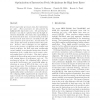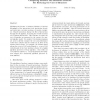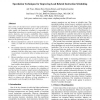135
click to vote
ASPLOS
2008
ACM
15 years 3 months ago
2008
ACM
The recent shift in the industry towards chip multiprocessor (CMP) designs has brought the need for multi-threaded applications to mainstream computing. As observed in several lim...
120
click to vote
ISCA
1995
IEEE
15 years 4 months ago
1995
IEEE
Recent superscalar processors issue four instructions per cycle. These processors are also powered by highly-parallel superscalar cores. The potential performance can only be expl...
115
click to vote
ATS
2004
IEEE
15 years 4 months ago
2004
IEEE
TIS (Test Instruction Set) is an instruction level technique for CPU core self-testing. This method is based on enhancing a CPU instruction set with test instructions. TIS replace...
ISCA
1989
IEEE
15 years 5 months ago
1989
IEEE
Pipelining has become a common technique to increase throughput of the instruction fetch, instruction decode, and instruction execution portions of modern computers. Branch instru...
105
click to vote
MICRO
1994
IEEE
15 years 5 months ago
1994
IEEE
Multiple issue of instructions occurs in superscalar and VLIW machines. This paper investigates a third type of machine design, which combines the advantages of code compatibility...
MICRO
1998
IEEE
15 years 5 months ago
1998
IEEE
The fill unit is the structure which collects blocks of instructions and combines them into multi-block segments for storage in a trace cache. In this paper, we expand the role of...
112
click to vote
ISCA
1998
IEEE
15 years 5 months ago
1998
IEEE
Branch prediction has enabled microprocessors to increase instruction level parallelism (ILP) by allowing programs to speculatively execute beyond control boundaries. Although spe...
ICCAD
1998
IEEE
15 years 5 months ago
1998
IEEE
111
click to vote
ISCA
1999
IEEE
15 years 5 months ago
1999
IEEE
State of the art microprocessors achieve high performance by executing multiple instructions per cycle. In an out-oforder engine, the instruction scheduler is responsible for disp...
ISCA
1999
IEEE
15 years 5 months ago
1999
IEEE
Value Prediction is a relatively new technique to increase instruction-level parallelism by breaking true data dependence chains. A value prediction architecture produces values, ...



